July 8, 2022
How To Find A Great Personal Trainer
How To Find A Great Personal Trainer: 6 Things You Need To Know
Nowadays, it seems just about everybody wants to be a personal trainer. Fitness influencers are all around us, and it's likely that they’ll just keep multiplying. Although the quantity of fitness “gurus” is far outweighing the quality, investing in a good personal trainer can be VERY beneficial.
A quality PT will provide you with excellent programming, make sure your form is optimal, give you nutritional advice or plans, and will probably become a life-long friend if you really click with one another.
Whether you’re looking for a trainer at your gym, someone to train you outdoors, a Zoom trainer, or any other type of trainer, keep these things in mind if you want to find the right one.
1. Knowledge and (Continued) Education
First and foremost, your trainer should have some sort of certification. A degree in some form of exercise or health science would be perfect, but there are great trainers without a degree.
Having a personal trainer certificate doesn't mean that a PT is a great coach and that they are continuing with their education, but it's a start.
The field of fitness and exercise is ever-changing, and the changes are coming in fast. That's why your trainer must be passionate about learning. Continued education is a must in the field. Stop paying attention for a year or two, and you'll be out of the loop.
2. Fancy Words and Exercises
Many trainers like using fancy terms and jargon that the general population won’t understand. Some will do it to impress you, some will do it because they aren’t secure in their knowledge and want to appear smart, while some do it because they don't know how to communicate in any other way.
If a trainer uses jargon you don’t understand, that doesn’t necessarily mean that they are BS’ing to impress you, but it's something you should pay attention to.
Another thing to keep in mind is the fancy exercises. If your coach switches up your workout every time you get into the gym, and no two workouts are the same, that can be a bit of a red flag.
If your goal is to be entertained in the gym, then great, they’re doing a terrific job. But if you’re there to progress and improve your health, not having some consistency with your workouts is a bad idea. Yes, there is a time to change things up. But every time is not it. To know if you’re making progress with each workout, you need to be able to compare apples to apples, not apples to oranges.
Everybody, especially beginners, can get tremendous results with the basics. Squats, deadlifts, bench presses, overhead presses, rows, and pullups are always the way to go. Of course, there are a lot of effective exercises, but the fundamentals are ALWAYS the most important.
If your trainer is making you balance on a Bosu ball while standing on one leg and doing a barbell curl with bands, something is up.
3. Initial Testing and Assessment
A quality coach will make sure to do some form of assessment with you before you start training. This includes asking you about your medical history, prior injuries, etc.
A postural assessment can be important if your goal is health or longevity-oriented. The trainer should take note of any imbalances or dysfunctions you may have.
Depending on your goals, they might make you do a few physical tests. Programming a workout plan without knowing the client's physical capabilities isn't possible. You don’t want a trainer that is just guessing their through it.
For example, if your goal is to improve your endurance, the trainer should test your VO2max. And if you want to get stronger, they should test your 1 or 3 rep maximum on specific exercises at one point.
Tests should be repeated after some time to ensure you're progressing and to know at what pace you are progressing. These tests keep both of you accountable, and they are an excellent motivator for you along your journey.
4. The Trainer Understands the Need for Rest and Progression
Without adequate rest, there's no progression. And without progression, we are just wasting time.
I know some trainers who just love to kill their clients every training session. It would be an understatement to say that's bad. Even Olympians need time for their bodies to recover, let alone a person just wanting to get fit. You get stronger and bigger while you rest and sleep. Even losing weight isn't possible without enough rest.
As for progression, progressive overload is one of the most (if not THEE most) important principles in training. Most people are familiar with this concept instinctually since they will try to lift more weight as time goes by, but you can achieve it in many other ways (examples – more reps done with a particular weight in an exercise, more work done in the same amount of time, the same amount of work done in less time, and better exercise execution).
5. Your Type of Motivation
This is an important one. We are all different, and we get motivated in different ways.
Some people need a trainer to push them hard in order to do anything, while others don't need any external motivation.
You need to figure out what type of person you are and what gets you excited. If that means you need someone to slap your face and scream before every set, go for a trainer who can give you that. The same goes for the other extreme. If you don't need any motivation from a trainer, find someone that won't scream at you.
Although not always, good trainers can modify the level of motivation they are bringing to every client, depending on their needs.
6. Being Real
Most people underestimate the time needed to get the results they want. It’s the PT’s job to tell the client otherwise and educate them.
People think they can get jacked or lose a hundred pounds of fat in 6 months. While you could maybe get close by using steroids, no good trainer would obviously suggest that.
Fitness is a lifestyle, and there aren't any shortcuts. If shortcuts existed, we'd all be walking around with a big butt and a complete set of 8 pack abs. Sadly, that’s not the case.
The most realistic rate of weight loss for most people will be around 1-2 lbs per week. That seems slow, but it's easier to keep weight off this way.
When it comes to building muscle mass, you can see the first results after about 4 weeks, but the gains you will see are probably minuscule compared to your fitness goals.
As the saying goes, “Most people overestimate what they can do in a year, and underestimate what they can do in 5 years.” A better timeline for fitness purposes would be “most people overestimate what they can do in one month, but underestimate what they can do in a year.” And because of that expectation, after that first month is up, many lose their motivation because they don’t feel they have progressed fast enough. But had they stayed course for the year, the results that could be achieved with some consistency would be amazing.
You have to be in it for the longer haul. Short cuts won’t…well…cut it.





